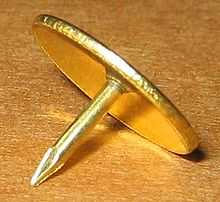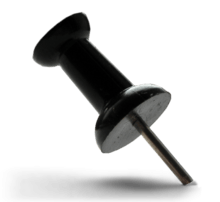Drawing pin

A thumb tack (North American English) or push pin is a short nail or pin used to fasten items to a wall or board for display and intended to be inserted by hand, generally without the assistance of tools. A variety of names are used to refer to different designs intended for various purpose. Thumb tack and push pin are both sometimes compounded (thumbtack or pushpin) or hyphenated (thumb-tack or push-pin). Thumb tacks made of brass, tin or iron may be referred to as brass tacks, brass pins, tin tacks or iron tacks, respectively.[1] These terms are particularly used in the idiomatic expression to come (or get) down to brass (or otherwise) tacks, meaning to consider basic facts of a situation.[2] Drawing pin or drawing-pin refers to thumb tacks used to hold drawings on drawing boards. Map pin or map tack refers to thumb tacks used to mark locations on a map and to hold the map in place.
History

Edwin Moore invented the "push-pin" in 1900 and founded the Moore Push-Pin Company. Moore described the push-pin as a pin with a handle. Later, in 1904, in Lychen, German clockmaker Johann Kirsten invented flat-headed thumb tacks for use with drawings.[3]
Design
A thumb tack has two basic components: the head, often made of plastic, metal or wood, and the body, usually made of steel or brass. The head is wide to distribute the force of pushing the tack in, allowing only the hands to be used. Many head designs exist: flat, domed, spherical, cylindrical and a variety of novelty heads such as hearts or stars. Thumb tack heads also come in a variety of colors. These can be particularly useful to mark different locations on a map. Some thumb tack designs have the body cut out of the head and bent downward to produce a tack.
Domed or gripped heads are sometimes preferred over flat heads as dropped flat-headed tacks will point upward, posing a hazard.[4] Thumb tacks also pose a hazard of ingestion and choking, where they may do serious harm.[5]
References
- ↑ "tack, n.1". Oxford English Dictionary. Oxford University Press.
- ↑ "brass, n.". Oxford English Dictionary. Oxford University Press.
- ↑ Rubino, Anthony (2011). Essential Shit: Bollock's! Why didn't I think Of That?. David & Charles. p. 56. ISBN 9781446354834.
- ↑ Teelucksingh, S; V Naraynsingh (July 1997). "Injury to diabetic feet by thumb tacks". The Lancet 350 (9070): 74. doi:10.1016/s0140-6736(05)66286-1.
- ↑ Robert, Rea (August 1949). "Perforation of the Esophagus by a Thumb Tack and Subsequent removal by an electromagnet". Journal of the American Medical Society: Otolaryngology—Head and Neck Surgery 50 (2).
| Wikimedia Commons has media related to pushpins. |
| Look up thumbtack in Wiktionary, the free dictionary. |